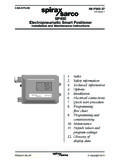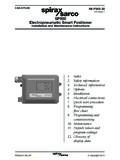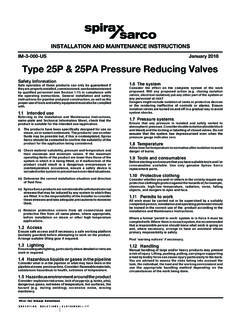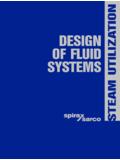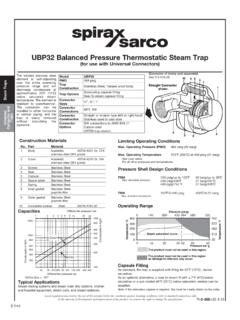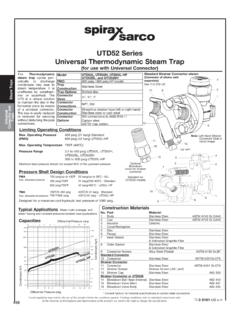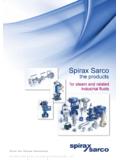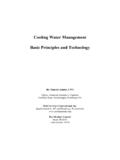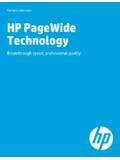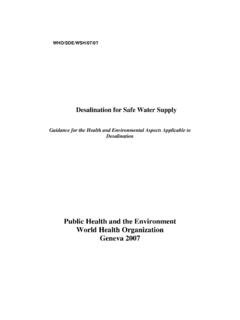Transcription of Steam Boiler Feedwater Storage Technology
1 Steam Boiler Feedwater Storage TechnologySupporting an energy efficient, highly reliable Steam systemWhite Paper Boiler Feedwater Storage Executive The role of the deaerator in Steam The need to remove dissolved oxygen and other gases from The components of an effective Feedwater system Feedtank construction Feedtank capacity Make-up water water level control Feedtank connections Sparge pipes Steam Deaerator systems Atmospheric deaerator systems Pressurised deaerator The Spirax Sarco Feedwater system Conclusion: Deaerators are critical for efficient and reliable Steam systemsContentsThis paper describes best practice for Boiler Feedwater system design and operation for owners and operators of Boiler Feedwater Storage system, or feedtank, and its associated components are vital for the correct and efficient operation of the entire industrial Steam and condensate system.
2 A correctly designed and implemented feedtank offers substantial savings in energy and water treatment costs, and increases the reliability of the Steam system for a more secure Steam feedtank is far more than simply a convenient way to store Boiler Feedwater . It provides a reliable source of Feedwater to the Boiler to meet fluctuating Steam demand and needs to maintain Boiler operations and protect the Boiler if the water supply also has an effective energy Storage and water conditioning role by storing the energy returned from the Steam and condensate system for re-use in the Boiler . Critically, it must balance and deaerate the returned condensate, flash Steam and raw water supplies to ensure maximum energy utilisation and liberate oxygen from the practice two alternatives exist to suit a Steam user s requirements: an atmospheric solution or a pressurised well-designed atmospheric deaerator raises the Feedwater temperature to approximately 85-90 C to remove dissolved oxygen from the water which would otherwise cause corrosion in the Steam and condensate system, and lead to rapid deterioration of the Boiler .
3 It can also reduce the need for oxygen scavenging chemicals such as sodium sulphite by as much as 75%.In certain installations that would benefit from a further reduction in the use of treatment chemicals, a pressurised deaerator can be implemented to heat the Feedwater to more than 100 C to drive off virtually all the oxygen. Pressurised deaerators are also thermally efficient. Steam system operators are advised to take advantage of a professional survey of their installed Feedwater system to ascertain the most effective ways to lower energy consumption, increase productivity, reduce maintenance and mitigate risk by complying with industry best practice and Health & Safety Executive SummaryThe Boiler feedtank plays an often under-estimated, yet vitally important role in the efficient and reliable operation of any industrial or building services Steam system.
4 The feedtank provides a reservoir of water for the Boiler , and should be sized to allow at least one hour of emergency Steam -generating capacity, depending on the criticality of plant operation, in the event of water supply interruption. It also contributes significantly to energy saving within the Steam plant by efficiently storing the energy from returned condensate and heat recovery systems. It must balance the Boiler Feedwater load with the returned condensate and make-up water to ensure the Boiler operates efficiently. It also has an important role as a conditioning unit for the Boiler an effective Boiler Feedwater system will help to avoid corrosion damage in the Boiler and Steam and condensate loop.
5 It helps to ensure the entire Steam system runs with minimum energy consumption and that modern package boilers are able to meet the fluctuating demands required by many of today s industries. A well-designed Feedwater system will also help protect a Steam system operator s capital investment by extending the lifetime of the industry sectors operating Steam Boiler plant can benefit by the correct implementation of a Boiler Feedwater Storage system using the latest technologies. The role of the feedtank in Steam systemsSteam Boiler Feedwater Storage well as providing a reservoir of water for the Boiler , the feedtank offers an opportunity to control the water quality entering the , which mechanically removes oxygen and other dissolved gases from the Feedwater , is proving to be beneficial in many EU markets and is currently gaining favour in the UK.
6 This benefit is driving the need for traditional feedtanks to be upgraded with additional atmospheric and pressurised deaeration of oxygen is important because untreated Boiler water contains as much as 10 mg/l of corrosion-causing dissolved oxygen at 15 C which, if left untreated, could lead to premature failure of wetted metal surfaces by oxidation corrosion resulting in rusty-looking nodules scattered throughout the Boiler and fire tubes. These nodules are the by-product of, and a protective housing for, oxidation corrosion. The size of the nodule does not necessarily indicate the depth of damage. The only way to completely stop the corrosion at this stage is to remove the nodule and the concentration of solids under it is important to maintain Feedwater temperature as high as possible to minimise the content of dissolved oxygen and avoid the formation of nodules.
7 Feedwater at an elevated temperature also reduces the risk of thermal shock in the Boiler when cold water hits the hot surfaces of the Boiler wall and its tubes. Furthermore, hot Feedwater improves the Boiler s responsiveness to varying load higher temperature Feedwater supply also reduces the work the Boiler has to do to raise Steam . Almost 10% less energy is required to raise 1 kg of Steam at 10 bar g from water at 70 C than at 10 target for dissolved oxygen in the Feedwater at the economiser inlet or, in the absence of an economiser, the Boiler Feedwater inlet, is zero dissolved oxygen. If a high proportion of make-up water is used, heating the Feedwater can substantially reduce the amount of oxygen scavenging chemicals that need to be introduced into the Feedwater system to help eliminate dissolved oxygen, reducing the cost of treatment Boiler water treatment and conditioning is covered in BS EN 12953 part 10 Shell boilers.
8 Requirements for Feedwater and Boiler water quality , and is referenced in BG01 Guidance on Safe Operations of Boilers. Boiler operators are advised to follow the guidance contained in these The need to remove dissolved oxygen and other gases from feedwaterOxygen content (parts per million) water temperature ( C)021446810120102030405060708090100 Figure 1: The oxygen content of Feedwater is reduced as its temperature is The components of an effective Feedwater systemThe design of a Feedwater system should focus on the effective integration of water treatment and heat recovery to support a more efficient, more reliable and lower emission Steam system.
9 Feedtank constructionWhile horizontal or vertical cylindrical feedtanks are not uncommon, most installations have a rectangular-shaped tank because this offers the optimum volume of water Storage for the floor area it the most commonly used material for the feedtank is carbon steel, which is relatively low cost but susceptible to corrosion. This drawback can be overcome with a suitable coating, but this substantially increases the tank s capital cost. Furthermore, the need for regular maintenance not only increases the operating cost, but difficult, time-consuming work procedures may be required to access confined spaces should the coating need to be 2: An atmospheric deaerator and its systems Steam Boiler Feedwater Storage iron sectional tanks are sometimes used, but are also likely to corrode and can suffer leaks at the joints between the stainless steel feedtanks have a higher initial cost but this is typically more than justified by a long operational life, low maintenance costs and by avoiding the cost of replacing a failed lower specification system.
10 Therefore Type 304L is generally selected as the most appropriate grade of stainless Feedtank capacityConventionally, the feedtank is sized to provide the Boiler with enough water for at least one hour s operation at maximum Boiler evaporation to cover the interruption of make-up water supply. The length of emergency Steam -generating capacity required depends on how critical the Steam supply is to the facility s operation and also needs to take into account the volume of condensate return may not be practical in larger plants which instead can be fitted with a smaller hotwell feedtank with additional cold treated water Storage .
